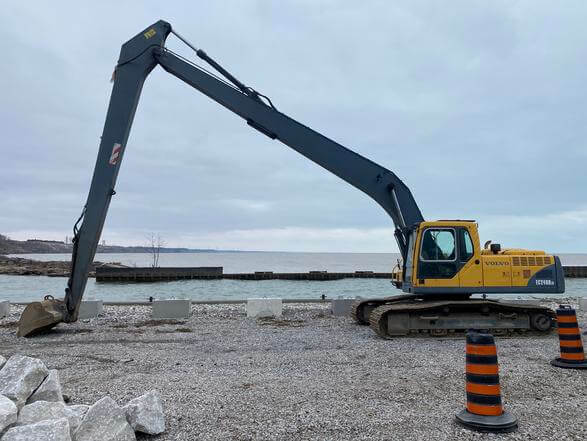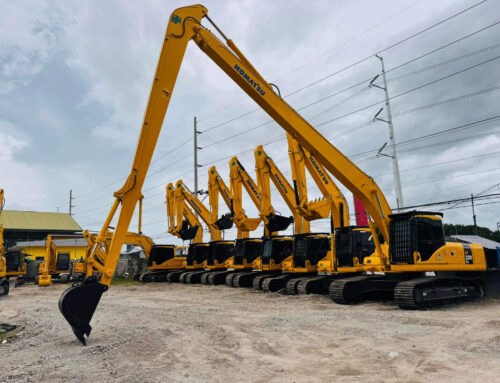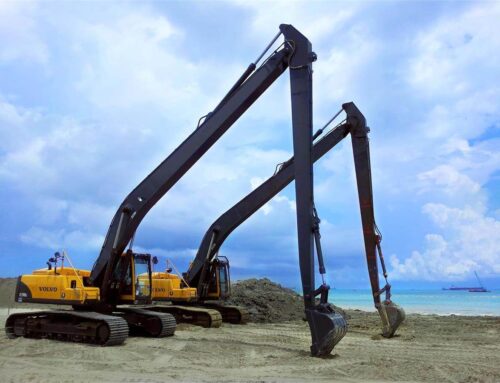Excavators are essential machines in the construction industry, widely used for digging, lifting, and moving large quantities of materials. The long arm of the excavator, also known as the boom, plays a critical role in these tasks. However, it’s not uncommon for the long arm of an excavator to break or sustain damage, leading to costly repairs and downtime. Understanding the reasons behind this failure and knowing how to prevent it can save both time and money.
Possible Reasons for the Long Arm of the Excavator Breaking
-
Material Fatigue
Explanation: Material fatigue is a common cause of structural failure in heavy machinery. The long arm of the excavator is subjected to repetitive stress and strain, which can cause microscopic cracks to form and grow over time. These cracks can eventually lead to a break.
Factors: The frequency and intensity of the work, combined with the quality of the materials used in manufacturing the arm, significantly affect material fatigue. Poor-quality steel or aluminum, often used to reduce costs, is more prone to fatigue.
-
Improper Use
Explanation: Excavators are designed for specific types of tasks and loads. Using the machine for purposes it wasn’t intended for, such as lifting excessively heavy objects or operating in environments that exceed its design specifications, can cause undue stress on the long arm.
Examples: Operating the excavator in extremely cold or hot environments, lifting loads beyond the machine’s rated capacity, or using the boom to perform tasks such as prying or hammering can all contribute to damage.
-
Poor Maintenance
Explanation: Regular maintenance is crucial for the longevity of any heavy machinery. Neglecting maintenance can lead to the deterioration of components and the overall structural integrity of the excavator’s arm.
Neglected Areas: Key areas that are often neglected include lubrication of pivot points, regular inspection for cracks or wear, and timely replacement of worn-out parts.
-
Hydraulic System Failures
Explanation: The hydraulic system is responsible for moving the long arm. Failures in this system, such as leaks, blockages, or pump failures, can cause uneven or excessive forces on the arm, leading to structural failure.
Indicators: Symptoms of hydraulic system issues include slow or jerky arm movements, oil leaks, and unusual noises from the hydraulic pump.
-
Welding Defects
Explanation: The joints and connections in the long arm are typically welded. Poor welding techniques or defects in the welding process can create weak points that are susceptible to breaking under stress.
Types of Defects: Common welding defects include cracks, porosity, incomplete fusion, and slag inclusions.
How to Prevent the Long Arm of the Excavator from Breaking
-
Regular Maintenance and Inspection
Scheduled Maintenance: Establish a regular maintenance schedule that includes detailed inspections of the long arm. Look for signs of wear, cracks, and other potential issues.
Lubrication: Ensure all moving parts and pivot points are adequately lubricated to reduce friction and wear.
Hydraulic System: Regularly check the hydraulic system for leaks, proper fluid levels, and the condition of hoses and seals.
-
Proper Usage
Training: Provide comprehensive training for operators on the correct use of the excavator. Emphasize the importance of adhering to the machine’s operational limits and the consequences of overloading or misuse.
Load Management: Always operate within the manufacturer’s specified load limits and ensure the load is evenly distributed to prevent excessive stress on any one part of the arm.
-
Quality Control in Manufacturing
Material Selection: Use high-quality materials that meet or exceed industry standards. Investing in better materials can reduce the risk of material fatigue.
Welding Quality: Ensure that all welding is performed by qualified professionals and that welds are inspected for defects. Non-destructive testing methods, such as ultrasonic or radiographic inspection, can be used to detect hidden flaws.
-
Hydraulic System Care
Regular Checks: Regularly inspect the hydraulic system for any signs of wear or damage. Replace worn or damaged components immediately.
Fluid Maintenance: Use the correct hydraulic fluids and change them according to the manufacturer’s recommendations. Contaminated or degraded fluids can cause hydraulic failures.
-
Environmental Considerations
Operational Environment: Be mindful of the operating environment. Avoid using the excavator in extreme temperatures unless it is specifically designed for such conditions.
Protective Measures: Implement protective measures such as shielding or insulating the machine if it must be used in harsh environments.
Conclusion
The long arm of the excavator is a critical component that can be prone to breaking due to various factors, including material fatigue, improper use, poor maintenance, hydraulic system failures, and welding defects. By understanding these potential issues and implementing preventive measures, operators and maintenance teams can significantly reduce the risk of arm failure. Regular maintenance, proper usage, quality manufacturing, diligent hydraulic system care, and environmental considerations are all essential to ensuring the longevity and reliability of an excavator’s long arm. Investing time and resources in these areas not only enhances safety but also improves productivity and reduces downtime in construction operations.







Leave A Comment